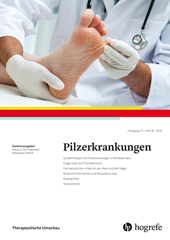Diagnostik von Pilzinfektionen
Abstract
Zusammenfassung. Die klinischen Zeichen einer Pilzinfektion sind häufig unspezifisch und es gibt meist viele mögliche Differentialdiagnosen. Laboruntersuchungen sind für die Diagnose deshalb essentiell. Für eine optimale Untersuchung ist die Präanalytik wichtig, es braucht eine korrekte Probenentnahme und genügend Informationen auf dem Laborauftrag. Die Methoden umfassen Mikroskopie, Kultur, Serologie (Biomarker) und Molekularbiologie. Je nach Mykose und je nach Infektionsort werden andere Methoden gewählt. In den letzten Jahren haben neue Entwicklungen bei serologischen und molekularbiologischen Methoden die Diagnostik erheblich verbessert und erlauben z. T. die Diagnosestellung, wo dies früher nicht möglich gewesen wäre.
Abstract. Clinical presentations of fungal infections are often non-specific and can be caused by a wide range of diseases. Therefore, laboratory tests are needed for diagnosis. For optimal investigation clinicians should provide the laboratory with adequate specimens and sufficient background information. The methods in the laboratory encompass microscopy, culture, serology (biomarkers) and molecular diagnosis. Appropriate methods differ from mycosis to mycosis as well as the site of infection. The direct microscopic examination is a fast, simple and useful method and should be done on every specimen where possible. Isolation in culture will permit identification of most pathogenic and resistance testing if necessary. In recent years, new developments in serological and molecular methods have improved the diagnostics substantially and allow diagnosis in cases where this previously was not possible. For example for invasive candidiasis and invasive aspergillosis both biomarkers and molecular tests on serum or other sample material are available which outweigh traditional diagnostics in terms of sensitivity and specificity.



